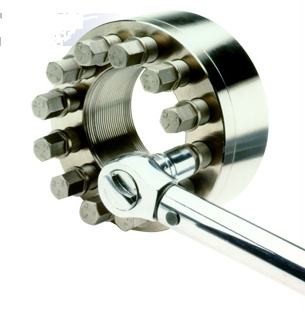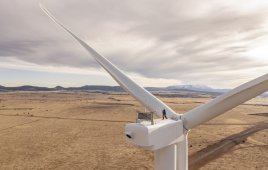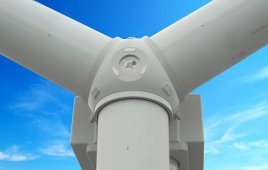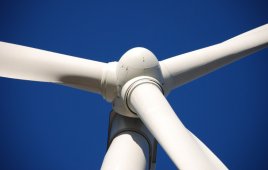
Multi-jackbolt tensioners are a solution when companies experience bolting problems such as leakage, thread galling, unsafe working conditions, or when using expensive methods and find it difficult to properly bolt the joint.
Although wind turbines vibrate enough now, more of it will come as engineers introduce designs with longer blades to capture more wind energy. Increased vibration levels may also loosen some tower fasteners which calls for occasional re-tightening. Hence, most trends in this area have tool designers looking for better ways to measure tension (rather than torque) and prevent corrosion. Other trends are toward lighter tools and a future trend is collaboration between construction workers and turbine engineers that will build design features that make it easier to tightening bolts outside the hub.
The best-way debate: There is a discussion in the bolting-tool community regarding a best way to produce or measure bolt tension. Standard procedure has been to measure pressure in hydraulic tools or current in electric tools, parameters that indicate having reached a torque that corresponded to a required bolt tension. The accuracy to the tension value generated is considered by some to be too low. According to one study, actual bolt tensions can vary as much as ± 40%.
One wrench manufacturer says the margin for torque error is a lot less with an electric wrench because the tools can be “locked” to a particular torque value. Such manufacturers say their tools work with ±3% accuracy. Additional wrench features include setting several torque limits at one time for different jobs workers may encounter that day.
To provide a closer measure of torque, one tool manufacturer provides a socket head with a built in strain gage. The tool can be used on all torque generators, hydraulic and electric alike.
Lighter and smarter wrenches are another bolting trend. Of course, lighter is a relative term. One bolting supply company took it upon itself to design an electric powered tension pump that clients were requesting. It’s 65% smaller than competing units.
In addition, bolting work requires accountability – knowing that each bolt is tightened to a prescribed level. More wind-turbine manufactures require proof that each bolt has been installed and applied to appropriate torque levels to maintain the manufacturer’s warranty. Recent electric torque wrenches allow collecting such data. On-board data loggers can report how many bolts have been torqued along with failed torques and over torques. One project manager estimates that electric torquing takes about 33% less time than by other methods.
Coatings and corrosion protection. The offshore industry is encouraging development of bolt coatings. The coatings are developed to protect industrial structures and equipment in corrosive conditions, referred to as C4 and C5, where saltwater and high humidity corrode unprotected steel. Chemist are giving zinc flake materials attention. One zinc flake material has passed ISO 12944 by tolerating 1,440 hours of salt spray without substrate corrosion. Another, Hempel’s Hempadure AvantGuard activated zinc primers include patented chemistry that they say provides better anti-corrosion protection than zinc epoxies without AvantGuard.
To ensure risk reduction of hydrogen embrittlement, AUGE bolting has developed an alternative cleaning method consisting of an alkaline de-scaling process. The results are in compliance with ASTM A153 and EN 10684 (thickness and adhesion tests). The process applies to hot-dip galvanized anchoring systems, through a process free of acidic solutions. The process allows reducing cost and lead-time by reducing the need for baking the steel.
Recommended future trends: If tool manufacturers would like new product ideas, ones that could start future trends say construction workers, build lighter tools. Holding a 45-lb tool overhead for hours is a lot to ask of a normal person, says one worker.
For example, a common 1.6 MW turbine with 100-m rotor sports 940 bolts not counting the 140 odd base bolts. Try tightening those in a day, he challenges tool makers. Then consider those outside-blade bolts (bearing to hub) on some machines. With no platform to stand on, no handles, no waist or chest high anchors, just the modest sized tie-off rail to stand on, and no access to the front of the nose cone, you quickly see these machines are not as worker friendly as they could be. Then add the weight of the torque gun, which may not have a lanyard-connection point, and a long electric-and-data cord and frequently encountered grease, and it becomes immediately obvious that lighter tools are needed along with safer access to outside bolts.
A recommended trend would be more collaboration between turbine OEMs or even major wind associations and tool manufacturers to address the issue.
Filed Under: Components, Featured, Turbines




